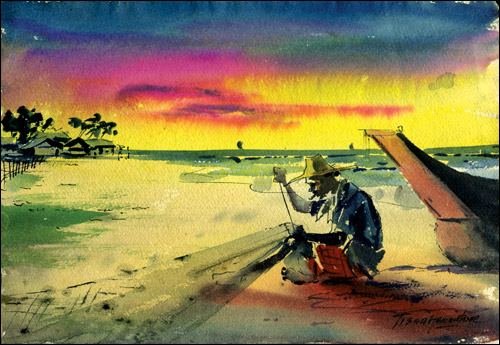Landscape light in water colour
Tissa Hewavitharane
Light is the life of a painting. Water colour, therefore, is the
ideal medium that is fresh, alive and responsive to the moment and the
shifting moods of nature. As you have observed nature is always changing
and we as painters must study and paint each colour and value carefully
and accordingly.
The earth depends on the value and the colours of the sky. We must
always be aware of the effect that light has on our painting.
|

Fisherman mending the net. |
Depending on the nature of the day, reflected light can be either a
very important part of your picture. The strong light of a clear day,
for example reflects colour into everything. At a beach, the brilliant
sun bounces light off the sand into the surrounding darks, obliterating
them. On a very dull day, however such effects are more subtle; the
reflected light is much harder to see.
Light and middle values against dark
The arrangement of values is very common. It is a clean, clear and
dramatic presentation of any subject. Most traditional landscapes
feature a light and middle value sky against a darker shape of the land.
More contemporary examples in water colour include fish of Joseph Raffel
and the nudes of Charles Reid.
Don’t confine yourself to use this value design when it appears to be
the only and obvious choice. If you ascertain that a dark shape would be
better expressed as a light and middle value shape, then by all means do
it.
The flopping of light, middle and dark values is a fundamental part
of your design vocabulary and should be used liberally. Transposing
values is a simple procedure.
What is offered as a dark shape made of middle and dark values is
transposed into a shape in which what had been middle value is now
light, and what had been dark is now middle. Just as outrageous colours
sometimes prove the best so also do alternative value organizations.
Dark and light values against middle values
On the three basic value organizations offered, this option is
potentially the most dramatic and also the most difficult.
Dramatic because of the strong contrast that happens on the major
subject matter. Difficult because the strong contrast can fracture the
subject into two unrelated shapes. When the contrast between the light
value the focal point and the middle value of the background are too
close, the light value and the middle
|
Working with water colour |
| * Ideal
medium to portray shifting moods of nature.
* Contemporary examples are
‘fish of Joseph Raffel’ and ‘nudes of Charles Reid’.
* Best if balanced between light
and dark colours. |
value of the background are too close, the light value and the middle
value join, and the dark shape is isolated. In other words, the light
and middle become one shape stands alone.
The same problem occurs when the dark and middle values get too
close. The critical factor is the values that surround the focal point.
Too light or too dark, and they wont work. Objects in directs, strong
sunlight are, frequently defined as light and dark against middle
values. An example is a white house in sunlight. The white in sunlight
is lighter than the sky, and the white in shadow is darker than the sky.
Once you decide to use this pattern, you must remain consistent. It’s
easy to get confused by local colour and find yourself vacillating
between patterns at one time painting the shadow of the house darker
than the sky and at other times lighter than the sky.
Expressive Colour
There seems to be a belief that if a painter matches each colour
exactly as seen, reality will be the result. Nothing could be farther
from the truth.
Observe the painting I have done titled ‘fisherman mending the net’.
If you see the colour of light, which exists and only colour which
emerged is mainly yellow.
To express my view of a sunset scene. The sky at sunset takes on a
radiant glow. Notice the colours used the warm pinks and golds of the
setting sun with cool blues and violets of the clouds, and gradually to
the stronger tones.
I have used subtle modulation of colour texture and tone to create a
lively impression of the sea shore. These subtle details are pleasing to
the eye, but they don’t detract from the focal point of the picture
which is the fisherman mending the net. To make the picture more live I
introduce a boat by the side in dark tones.
I felt the best way to describe the sun set was strong value
contrast. It was my intention to first express the quality of strong
light using pure, clear transparent pigments thus increasing the
impression of light and luminosity. A light wash indicates the fisherman
net.
Remember colour is an equal and essential partner when portraying
light. It is not enough to squint your eyes and see only values. You
must look into the shadows and identify the colours that are there.
Don’t look for formulas or short cuts to tell you what colours,
shadows should be or always are. Look for the warm colours in the shade
and cools in the sunlight. It takes some practice to allow your eyes to
see shapes, values and colours.
www.tissahewavitarane.com |



